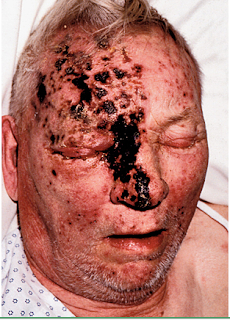2 min read - Herpes Zoster
This lady presented with a painful rash over the face for 2 days' duration.
What is this?
This is reactivation of varicella-zoster infection in the ophthalmic division of trigeminal ganglion, also known as herpes zoster or shingles.
What are the features?
The diagnosis is easy and the presentation is typical. Patients present like this with an extremely painful vesicular eruption confined to a single dermatome. Sometimes pain can be the presenting complaint and the rash can appear later.
Who can get this?
Anyone! But you see more complications in the elderly and in those who are immune compromised.
Is it contagious?
Until the vesicles are crusted, it is contagious. So try to keep the rash covered if possible, and get the patient to wash hands frequently!
So the treatment is aciclovir and gabapentin, isn't it?
Well, in some patients that may suffice. But not in this patient.
Why?
One thing you should not miss is the extension of the rash to the tip of the nose. It signifies the involvement of the nasociliary branch of the trigeminal nerve, which also innervates the eye globe. This is called the 'Hutchinson's sign', and it carries a high risk of eye complications.
What are those eye complications?
There can be involvement of all parts of the eye depending on the severity. IT IS POTENTIALLY SIGHT THREATENING. The most dreaded complication is acute retinal necrosis. Even keratitis alone can cause loss of vision.
So what needs to be done?
Start treatment and refer to an eye surgeon as early as possible.
Aciclovir 800mg five times a day for seven days should be given.
What is the treatment for pain?
Early pain is due to acute neuritis. NSAIDs and opioids are the treatment of choice, not gabapentin. But the long-standing pain after the acute episode, ie. Postherpetic neuralgia, is treated by drugs like gabapentin, pregabalin, and amitriptyline.
Anything else?
Watch out for secondary bacterial infections, and treat at the earliest suspicion.
(All pictures from internet)
 |
| (Picture from internet) |
This is reactivation of varicella-zoster infection in the ophthalmic division of trigeminal ganglion, also known as herpes zoster or shingles.
What are the features?
The diagnosis is easy and the presentation is typical. Patients present like this with an extremely painful vesicular eruption confined to a single dermatome. Sometimes pain can be the presenting complaint and the rash can appear later.
Who can get this?
Anyone! But you see more complications in the elderly and in those who are immune compromised.
Is it contagious?
Until the vesicles are crusted, it is contagious. So try to keep the rash covered if possible, and get the patient to wash hands frequently!
So the treatment is aciclovir and gabapentin, isn't it?
 |
| Herpes Zoster Ophthalmicus |
Well, in some patients that may suffice. But not in this patient.
Why?
One thing you should not miss is the extension of the rash to the tip of the nose. It signifies the involvement of the nasociliary branch of the trigeminal nerve, which also innervates the eye globe. This is called the 'Hutchinson's sign', and it carries a high risk of eye complications.
What are those eye complications?
There can be involvement of all parts of the eye depending on the severity. IT IS POTENTIALLY SIGHT THREATENING. The most dreaded complication is acute retinal necrosis. Even keratitis alone can cause loss of vision.
 |
| Acute retinal necrosis |
So what needs to be done?
Start treatment and refer to an eye surgeon as early as possible.
Aciclovir 800mg five times a day for seven days should be given.
What is the treatment for pain?
Early pain is due to acute neuritis. NSAIDs and opioids are the treatment of choice, not gabapentin. But the long-standing pain after the acute episode, ie. Postherpetic neuralgia, is treated by drugs like gabapentin, pregabalin, and amitriptyline.
Anything else?
Watch out for secondary bacterial infections, and treat at the earliest suspicion.
(All pictures from internet)



Comments
Post a Comment